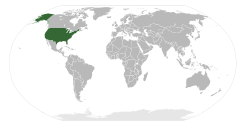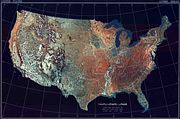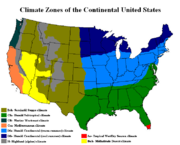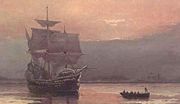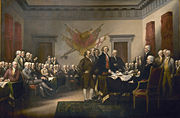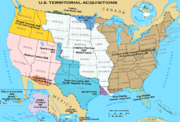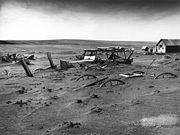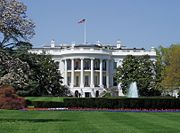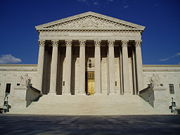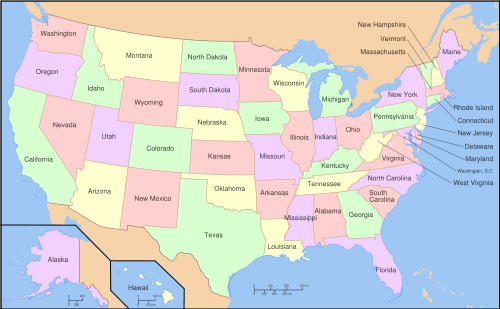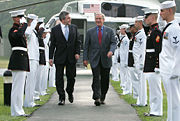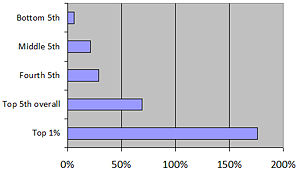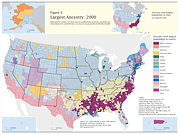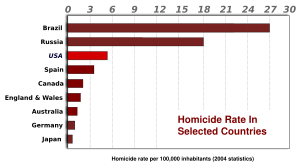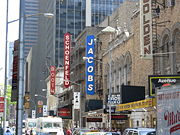United States
2008/9 Schools Wikipedia Selection. Related subjects: Americas; North American Geography
| United States of America | ||||||
|---|---|---|---|---|---|---|
|
||||||
| Motto: In God We Trust (official) E Pluribus Unum (From Many, One; Latin, traditional) |
||||||
| Anthem: " The Star-Spangled Banner" |
||||||
|
|
||||||
| Capital | Washington, D.C. |
|||||
| Largest city | New York City | |||||
| Official languages | None at federal level1 | |||||
| National language | English ( de facto)2 | |||||
| Demonym | American | |||||
| Government | Constitutional federal presidential republic | |||||
| - | President | George W. Bush ( R) | ||||
| - | Vice President | Dick Cheney ( R) | ||||
| - | Speaker of the House | Nancy Pelosi ( D) | ||||
| - | Chief Justice | John Roberts | ||||
| Independence from the Kingdom of Great Britain | ||||||
| - | Declared | July 4, 1776 | ||||
| - | Recognized | September 3, 1783 | ||||
| - | Current constitution | June 21, 1788 | ||||
| Area | ||||||
| - | Total | 9,826,630 km² ( 3rd/4th3) 3,794,066 sq mi |
||||
| - | Water (%) | 6.76 | ||||
| Population | ||||||
| - | 2008 estimate | 304,832,000 ( 3rd4) | ||||
| - | 2000 census | 281,421,906 | ||||
| - | Density | 31/km² ( 180th) 80/sq mi |
||||
| GDP ( PPP) | 2007 estimate | |||||
| - | Total | $13.543 trillion ( 1st) | ||||
| - | Per capita | $43,444 ( 4th) | ||||
| GDP (nominal) | 2007 estimate | |||||
| - | Total | $13.794 trillion ( 1st) | ||||
| - | Per capita | $43,594 ( 9th) | ||||
| Gini (2006) | 47.0 (high) | |||||
| HDI (2005) | 0.951 (high) ( 12th) | |||||
| Currency | United States dollar ($) ( USD "$") |
|||||
| Time zone | ( UTC-5 to -10) | |||||
| - | Summer ( DST) | ( UTC-4 to -10) | ||||
| Internet TLD | .us .gov .mil .edu | |||||
| Calling code | +1 | |||||
| 1 | English is the official language of at least 28 states—some sources give a higher figure, based on differing definitions of "official." English and Hawaiian are both official languages in the state of Hawaii. | |||||
| 2 | English is the de facto language of American government and the sole language spoken at home by 82% of Americans age five and older. Spanish is the second most commonly spoken language. | |||||
| 3 | Whether the United States or the People's Republic of China is larger is disputed. The figure given is per the U.S. Central Intelligence Agency's World Factbook. Other sources give smaller figures. All authoritative calculations of the country's size include only the fifty states and the District of Columbia, not the territories. | |||||
| 4 | The population estimate includes people whose usual residence is in the fifty states and the District of Columbia, including noncitizens. It does not include either those living in the territories, amounting to more than four million U.S. citizens (most in Puerto Rico), or U.S. citizens living outside the United States. | |||||
The United States of America is a constitutional federal republic comprising fifty states and a federal district, as well as several territories, or insular areas, scattered around the Caribbean and Pacific. The country is situated mostly in central North America, where its forty-eight contiguous states and Washington, D.C., the capital district, lie between the Pacific and Atlantic Oceans, bordered by Canada to the north and Mexico to the south. The state of Alaska is in the northwest of the continent, with Canada to its east and Russia to the west across the Bering Strait, and the state of Hawaii is an archipelago in the mid-Pacific.
At 3.79 million square miles (9.83 million km²) and with more than 300 million people, the United States is the third or fourth largest country by total area, and third largest by land area and by population. The United States is one of the world's most ethnically diverse nations, the product of large-scale immigration from many countries. The U.S. economy is the largest national economy in the world, with a nominal 2006 gross domestic product (GDP) of more than US$13 trillion (over 19% of the world total based on purchasing power parity).
The nation was founded by thirteen colonies of Great Britain located along the Atlantic seaboard. Proclaiming themselves "states," they issued the Declaration of Independence on July 4, 1776. The rebellious states defeated Great Britain in the American Revolutionary War, the first successful colonial war of independence. A federal convention adopted the current United States Constitution on September 17, 1787; its ratification the following year made the states part of a single republic. The Bill of Rights, comprising ten constitutional amendments, was ratified in 1791.
In the nineteenth century, the United States acquired land from France, Spain, the United Kingdom, Mexico, and Russia, and annexed the Republic of Texas and the Republic of Hawaii. Disputes between the agrarian South and industrial North over states' rights and the expansion of the institution of slavery provoked the American Civil War of the 1860s. The North's victory prevented a permanent split of the country and led to the end of slavery in the United States. The Spanish-American War and World War I confirmed the nation's status as a military power. In 1945, the United States emerged from World War II as the first country with nuclear weapons, a permanent member of the United Nations Security Council, and a founding member of NATO. In the post–Cold War era, the United States is the only remaining superpower—accounting for approximately 50% of global military spending—and a dominant economic, political, and cultural force in the world.
Etymology
The term America, for the lands of the western hemisphere, was coined in 1507 after Amerigo Vespucci, an Italian explorer and cartographer (presumably named after St. Emeric). The full name of the country was first used officially in the Declaration of Independence, which was the "unanimous Declaration of the thirteen united States of America" adopted by the "Representatives of the united States of America" on July 4, 1776. The current name was finalized on November 15, 1777, when the Second Continental Congress adopted the Articles of Confederation, the first of which states, "The Stile of this Confederacy shall be 'The United States of America.'" Common short forms and abbreviations of the United States of America include the United States, the U.S., the U.S.A., and America. Colloquial names for the country include the U.S. of A. and the States. Columbia, a once popular name for the Americas and the United States, was derived from Christopher Columbus. It appears in the name "District of Columbia". A female personification of Columbia appears on some official documents, including certain prints of U.S. currency.
The standard way to refer to a citizen of the United States is as an American. Though United States is the formal adjective, American and U.S. are the most common adjectives used to refer to the country ("American values," "U.S. forces"). American is rarely used in English to refer to people not connected to the United States.
The phrase "the United States" was originally treated as plural—e.g, "the United States are"—including in the Thirteenth Amendment to the Constitution, ratified in 1865. However, it became increasingly common to treat the name as singular—e.g., "the United States is"—after the end of the Civil War. The singular form is now standard, while the plural form is retained in the set idiom "these United States."
Geography
The United States is situated almost entirely in the western hemisphere: the contiguous United States stretches from the Pacific on the west to the Atlantic on the east, with the Gulf of Mexico to the southeast, and bordered by Canada on the north and Mexico on the south. Alaska is the largest state in area; separated from the contiguous U.S. by Canada, it touches the Pacific on the south and Arctic Ocean on the north. Hawaii occupies an archipelago in the central Pacific, southwest of North America. The United States is the world's third or fourth largest nation by total area, before or after China. The ranking varies depending on (a) how two territories disputed by China and India are counted and (b) how the total size of the United States is calculated: the CIA World Factbook gives 9,826,630 km² (3,794,083 sq mi), the United Nations Statistics Division gives 9,629,091 km² (3,717,813 sq mi), and the Encyclopedia Britannica gives 9,522,055 km² (3,676,486 sq mi). Including only land area, the United States is third in size behind Russia and China, just ahead of Canada. The United States also possesses several insular territories scattered around the West Indies (e.g., the commonwealth of Puerto Rico) and the Pacific (e.g., Guam).
The coastal plain of the Atlantic seaboard gives way further inland to deciduous forests and the rolling hills of the Piedmont. The Appalachian Mountains divide the eastern seaboard from the Great Lakes and the grasslands of the Midwest. The Mississippi–Missouri River, the world's fourth longest river system, runs mainly north-south through the heart of the country. The flat, fertile prairie land of the Great Plains stretches to the west, interrupted by a highland region along its southeastern portion. The Rocky Mountains, at the western edge of the Great Plains, extend north to south across the continental United States, reaching altitudes higher than 14,000 feet (4,300 m) in Colorado. The area to the west of the Rocky Mountains is dominated by the rocky Great Basin and deserts such as the Mojave. The Sierra Nevada range runs parallel to the Rockies, relatively close to the Pacific coast. At 20,320 feet (6,194 m), Alaska's Mount McKinley is the country's tallest peak. Active volcanoes are common throughout the Alexander and Aleutian Islands, and the entire state of Hawaii is built upon tropical volcanic islands. The supervolcano underlying Yellowstone National Park in the Rockies is the continent's largest volcanic feature.
Because of the United States' large size and wide range of geographic features, nearly every type of climate is represented. The climate is temperate in most areas, tropical in Hawaii and southern Florida, polar in Alaska, semi-arid in the Great Plains west of the 100th meridian, desert in the Southwest, Mediterranean in Coastal California, and arid in the Great Basin. Extreme weather is not uncommon—the states bordering the Gulf of Mexico are prone to hurricanes, and most of the world's tornadoes occur within the continental United States, primarily in the Midwest's Tornado Alley.
Environment
U.S. plant life is very diverse; the country has more than 17,000 identified native species of flora. More than 400 mammal, 700 bird, 500 reptile and amphibian, and 90,000 insect species have been documented. The Endangered Species Act of 1973 protects threatened and endangered species and their habitats, which are monitored by the U.S. Fish and Wildlife Service.
The U.S. has fifty-eight national parks and hundreds of other federally managed parks, forests, and wilderness areas. Altogether, the U.S. government regulates 28.8% of the country's total land area. Most such public land comprises protected parks and forestland, though some federal land is leased for oil and gas drilling, mining, or cattle ranching.
The energy policy of the United States is widely debated; many call on the country to take a leading role in fighting global warming. The United States is currently the second largest emitter, after the People's Republic of China, of carbon dioxide from the burning of fossil fuels.
History
Native Americans and European settlers
The indigenous peoples of the U.S. mainland, including Alaska Natives, are thought to have migrated from Asia. They began arriving at least 12,000 and as many as 40,000 years ago. Several indigenous communities in the pre-Columbian era developed advanced agriculture, grand architecture, and state-level societies. In 1492, Genoese explorer Christopher Columbus, under contract to the Spanish crown, reached several Caribbean islands, making first contact with the indigenous population. In the years that followed, the majority of the indigenous American peoples were killed by epidemics of Eurasian diseases.
On April 2, 1513, Spanish conquistador Juan Ponce de León landed on what he called " La Florida"—the first documented European arrival on what would become the U.S. mainland. Of the colonies Spain established in the region, only St. Augustine, founded in 1565, remains. Later Spanish settlements in the present-day southwestern United States drew thousands through Mexico. French fur traders established outposts of New France around the Great Lakes; France eventually claimed much of the North American interior as far south as the Gulf of Mexico. The first successful English settlements were the Virginia Colony in Jamestown in 1607 and the Pilgrims' Plymouth Colony in 1620. The 1628 chartering of the Massachusetts Bay Colony resulted in a wave of migration; by 1634, New England had been settled by some 10,000 Puritans. Between the late 1610s and the American Revolution, an estimated 50,000 convicts were shipped to England's, and later Great Britain's, American colonies. Beginning in 1614, the Dutch established settlements along the lower Hudson River, including New Amsterdam on Manhattan Island. The small settlement of New Sweden, founded along the Delaware River in 1638, was taken over by the Dutch in 1655.
By 1674, English forces had won the former Dutch colonies in the Anglo-Dutch Wars; the province of New Netherland was renamed New York. Many new immigrants, especially to the South, were indentured servants—some two-thirds of all Virginia immigrants between 1630 and 1680. By the turn of the century, African slaves were becoming the primary source of bonded labor. With the 1729 division of the Carolinas and the 1732 colonization of Georgia, the thirteen British colonies that would become the United States of America were established. All had active local and colonial governments with elections open to most free men, with a growing devotion to the ancient rights of Englishmen and a sense of self government that stimulated support for republicanism. All had legalized the African slave trade. With high birth rates, low death rates, and steady immigration, the colonies doubled in population every twenty-five years. The Christian revivalist movement of the 1730s and 1740s known as the Great Awakening fueled interest in both religion and religious liberty. In the French and Indian War, British forces seized Canada from the French, but the francophone population remained politically isolated from the southern colonies. By 1770, those thirteen colonies had an increasingly Anglicized population of three million, approximately half that of Britain. Though subject to British taxation, they were given no representation in the Parliament of Great Britain.
Independence and expansion
Tensions between American colonials and the British during the revolutionary period of the 1760s and early 1770s led to the American Revolutionary War, fought from 1775 through 1781. On June 14, 1775, the Continental Congress, convening in Philadelphia, established a Continental Army under the command of George Washington. Proclaiming that " all men are created equal" and endowed with "certain unalienable Rights," the Congress adopted the Declaration of Independence on July 4, 1776. The Declaration, drafted largely by Thomas Jefferson, pronounced the colonies sovereign " states." In 1777, the Articles of Confederation were adopted, uniting the states under a weak federal government that operated until 1788. Some 70,000–80,000 loyalists to the British Crown fled the rebellious states, many to Nova Scotia and the new British holdings in Canada. Native Americans, with divided allegiances, fought on both sides of the war's western front.
After the defeat of the British army by American forces who were assisted by the French, Great Britain recognized the sovereignty of the thirteen states in 1783. A constitutional convention was organized in 1787 by those who wished to establish a strong national government with power over the states. By June 1788, nine states had ratified the United States Constitution, sufficient to establish the new government; the republic's first Senate, House of Representatives, and president—George Washington—took office in 1789. New York City was the federal capital for a year, before the government relocated to Philadelphia. In 1791, the states ratified the Bill of Rights, ten amendments to the Constitution forbidding federal restriction of personal freedoms and guaranteeing a range of legal protections. Attitudes toward slavery were shifting; a clause in the Constitution protected the African slave trade only until 1808. The Northern states abolished slavery between 1780 and 1804, leaving the slave states of the South as defenders of the " peculiar institution." In 1800, the federal government moved to the newly founded Washington, D.C. The Second Great Awakening made evangelicalism a force behind various social reform movements.
Americans' eagerness to expand westward began a cycle of Indian Wars that stretched to the end of the nineteenth century, as Native Americans were stripped of their land. The Louisiana Purchase of French-claimed territory under President Thomas Jefferson in 1803 virtually doubled the nation's size. The War of 1812, declared against Britain over various grievances and fought to a draw, strengthened American nationalism. A series of U.S. military incursions into Florida led Spain to cede it and other Gulf Coast territory in 1819. The country annexed the Republic of Texas in 1845. The concept of Manifest Destiny was popularized during this time. The 1846 Oregon Treaty with Britain led to U.S. control of the present-day American Northwest. The U.S. victory in the Mexican-American War resulted in the 1848 cession of California and much of the present-day American Southwest. The California Gold Rush of 1848–49 further spurred western migration. New railways made relocation much less arduous for settlers and increased conflicts with Native Americans. Over a half-century, up to 40 million American bison, commonly called buffalo, were slaughtered for skins and meat and to ease the railways' spread. The loss of the bison, a primary economic resource for the plains Indians, was an existential blow to many native cultures.
Civil War and industrialization
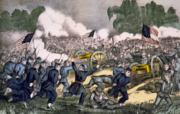
Tensions between slave and free states mounted with increasing disagreements over the relationship between the state and federal governments and violent conflicts over the expansion of slavery into new states. Abraham Lincoln, candidate of the largely antislavery Republican Party, was elected president in 1860. Before he took office, seven slave states declared their secession from the United States, forming the Confederate States of America. The federal government maintained secession was illegal, and with the Confederate attack upon Fort Sumter, the American Civil War began and four more slave states joined the Confederacy. The Union freed Confederate slaves as its army advanced through the South. Following the Union victory in 1865, three amendments to the U.S. Constitution ensured freedom for the nearly four million African Americans who had been slaves, made them citizens, and gave them voting rights. The war and its resolution led to a substantial increase in federal power.

After the war, the assassination of President Lincoln radicalized Republican Reconstruction policies aimed at reintegrating and rebuilding the Southern states while ensuring the rights of the newly freed slaves. The resolution of the disputed 1876 presidential election by the Compromise of 1877 ended Reconstruction; Jim Crow laws soon disenfranchised many African Americans. In the North, urbanization and an unprecedented influx of immigrants hastened the country's industrialization. The wave of immigration, which lasted until 1929, provided labor for U.S. businesses and transformed American culture. High tariff protections, national infrastructure building, and new banking regulations encouraged industrial growth. The 1867 Alaska purchase from Russia completed the country's mainland expansion. The Wounded Knee massacre in 1890 was the last major armed conflict of the Indian Wars. In 1893, the indigenous monarchy of the Pacific Kingdom of Hawaii was overthrown in a coup led by American residents; the archipelago was annexed by the United States in 1898. Victory in the Spanish-American War that same year demonstrated that the United States was a major world power and resulted in the annexation of Puerto Rico and the Philippines. The Philippines gained independence a half-century later; Puerto Rico remains a commonwealth of the United States.
World War I, Great Depression, and World War II
At the outbreak of World War I in 1914, the United States remained neutral. Americans sympathized with the British and French, although many citizens, mostly Irish and German, opposed intervention. In 1917, the United States joined the Allies, turning the tide against the Central Powers. Reluctant to be involved in European affairs, the Senate did not ratify the Treaty of Versailles, which established the League of Nations. The country pursued a policy of unilateralism, verging on isolationism. In 1920, the women's rights movement won passage of a constitutional amendment granting women's suffrage. Partly because of the service of many in the war, Native Americans gained U.S. citizenship in the Indian Citizenship Act of 1924.
During most of the 1920s, the United States enjoyed a period of unbalanced prosperity as farm profits fell while industrial profits grew. A rise in debt and an inflated stock market culminated in the 1929 crash that triggered the Great Depression. After his election as president in 1932, Franklin D. Roosevelt responded with the New Deal, a range of policies increasing government intervention in the economy. The Dust Bowl of the mid-1930s impoverished many farming communities and spurred a new wave of western migration. The nation would not fully recover from the economic depression until the industrial mobilization spurred by its entrance into World War II. The United States, effectively neutral during the war's early stages after the Nazi invasion of Poland in September 1939, began supplying materiel to the Allies in March 1941 through the Lend-Lease program.
On December 7, 1941, the United States joined the Allies against the Axis powers after a surprise attack on Pearl Harbour by Japan. World War II cost far more money than any other war in American history, but it boosted the economy by providing capital investment and jobs, while bringing many women into the labor market. Among the major combatants, the United States was the only nation to become richer—indeed, far richer—instead of poorer because of the war. Allied conferences at Bretton Woods and Yalta outlined a new system of international organizations that placed the United States and Soviet Union at the centre of world affairs. As victory was achieved in Europe, a 1945 international conference held in San Francisco produced the United Nations Charter, which became active after the war. The United States, having developed the first nuclear weapons, used them on the Japanese cities of Hiroshima and Nagasaki in August. Japan surrendered on September 2, ending the war.
Cold War and civil rights
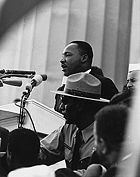
The United States and Soviet Union jockeyed for power after World War II during the Cold War, dominating the military affairs of Europe through NATO and the Warsaw Pact. The United States promoted liberal democracy and capitalism, while the Soviet Union promoted communism and a centrally planned economy. Both the United States and the Soviet Union supported dictatorships, and both engaged in proxy wars. United States troops fought Communist Chinese forces in the Korean War of 1950–53. The House Un-American Activities Committee pursued a series of investigations into suspected leftist subversion, while Senator Joseph McCarthy became the figurehead of anticommunist sentiment.
The Soviet Union launched the first manned spacecraft in 1961, prompting U.S. efforts to raise proficiency in mathematics and science and President John F. Kennedy's call for the country to be first to land "a man on the moon," achieved in 1969. Kennedy also faced a tense nuclear showdown with Soviet forces in Cuba. Meanwhile, America experienced sustained economic expansion. A growing civil rights movement headed by prominent African Americans, such as Martin Luther King, Jr., fought segregation and discrimination, leading to the abolition of Jim Crow laws. Following Kennedy's assassination in 1963, the Civil Rights Act of 1964 was passed under President Lyndon B. Johnson. Johnson and his successor, Richard Nixon, expanded a proxy war in Southeast Asia into the unsuccessful Vietnam War.
As a result of the Watergate scandal, in 1974 Nixon became the first U.S. president to resign, rather than be impeached on charges including obstruction of justice and abuse of power; he was succeeded by Vice President Gerald Ford. During the Jimmy Carter administration in the late 1970s, the U.S. economy experienced stagflation. The election of Ronald Reagan as president in 1980 marked a significant rightward shift in American politics, reflected in major changes in taxation and spending priorities. In the late 1980s and 1990s, the Soviet Union's power diminished, leading to its collapse and effectively ending the Cold War.
Contemporary era
The leadership role taken by the United States and its allies in the United Nations–sanctioned Gulf War, under President George H. W. Bush, and later the Yugoslav wars helped to preserve its position as the world's last remaining superpower. The longest economic expansion in modern U.S. history—from March 1991 to March 2001—encompassed the administrations of Presidents George H.W. Bush, Bill Clinton, and George W. Bush. In 1998, Clinton was impeached by the House on charges relating to a civil lawsuit and a sexual scandal, but he was acquitted by the Senate and remained in office.
The 1990’s also saw a rise in Islamic Terrorism against Americans from al-Qaeda and other groups, including an attack on the World Trade Centre in 1993, an attack on U.S. forces in Somalia, the 1996 Khobar Towers bombing, the 1998 United States embassy bombings in Tanzania and Kenya, the 2000 millennium attack plots, and the USS Cole bombing in Yemen in October 2000. In Iraq, the regime of Saddam Hussein proved a continuing problem for the UN and its neighbors, prompting a variety of UN sanctions, Anglo-American patrolling of Iraqi no-fly zones, Operation Desert Fox, and the Iraq Liberation Act of 1998 which called for the removal of the Hussein regime and its replacement by a democratic system.
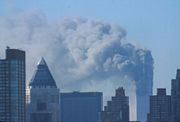
The presidential election of 2000 was one of the closest in U.S. history and saw George W. Bush become President of the United States. On September 11, 2001, al-Qaeda terrorists struck the World Trade Centre in New York City and The Pentagon near Washington, D.C., killing nearly three thousand people. In the aftermath, President Bush urged support from the international community for what was dubbed the War on Terrorism. In late 2001, U.S. forces launched Operation Enduring Freedom removing the Taliban government and al-Qaeda training camps. Taliban insurgents continue to fight a guerrilla war against a NATO-led force. Controversies arose regarding the conduct of the War on Terror.
Using language from the 1998 Iraq Liberation Act and the Clinton Administration, in 2002 the Bush Administration began to press for regime change in Iraq. With broad bipartisan support in the U.S. Congress, Bush formed an international Coalition of the Willing and in March 2003 ordered Operation Iraqi Freedom, removing Saddam Hussein from power. Although facing pressure to withdraw, the U.S.-led coalition maintains a presence in Iraq and continues to train and mentor a new Iraqi military as well as lead economic and infrastructure development.
In the upcoming 2008 presidential election, the Republican Party candidate, four-term Senator John McCain of Arizona – a former U.S. prisoner of war who served in the Vietnam War – will face the Democratic Party candidate, freshman Senator Barack Obama of Illinois, the first African American to head a major political party's presidential ticket.
Government and elections

The United States is the world's oldest surviving federation. It is a constitutional republic, "in which majority rule is tempered by minority rights protected by law." It is fundamentally structured as a representative democracy, though U.S. citizens residing in the territories are excluded from voting for federal officials. The government is regulated by a system of checks and balances defined by the United States Constitution, which serves as the country's supreme legal document and as a social contract for the people of the United States. In the American federalist system, citizens are usually subject to three levels of government, federal, state, and local; the local government's duties are commonly split between county and municipal governments. In almost all cases, executive and legislative officials are elected by a plurality vote of citizens by district. There is no proportional representation at the federal level, and it is very rare at lower levels. Federal and state judicial and cabinet officials are typically nominated by the executive branch and approved by the legislature, although some state judges and officials are elected by popular vote.
The federal government is composed of three branches:
- Legislative: The bicameral Congress, made up of the Senate and the House of Representatives, makes federal law, declares war, approves treaties, has the power of the purse, and has the power of impeachment, by which it can remove sitting members of the government.
- Executive: The president is the commander-in-chief of the military, can veto legislative bills before they become law, and appoints the Cabinet and other officers, who administer and enforce federal laws and policies.
- Judicial: The Supreme Court and lower federal courts, whose judges are appointed by the president with Senate approval, interpret laws and can overturn laws they deem unconstitutional.
The House of Representatives has 435 members, each representing a congressional district for a two-year term. House seats are apportioned among the fifty states by population every tenth year. As of the 2000 census, seven states have the minimum of one representative, while California, the most populous state, has fifty-three. Each state has two senators, elected at-large to six-year terms; one third of Senate seats are up for election every second year. The president serves a four-year term and may be elected to the office no more than twice. The president is not elected by direct vote, but by an indirect electoral college system in which the determining votes are apportioned by state. The Supreme Court, led by the Chief Justice of the United States, has nine members, who serve for life.
All laws and procedures of both state and federal governments are subject to review, and any law ruled in violation of the Constitution by the judicial branch is overturned. The original text of the Constitution establishes the structure and responsibilities of the federal government, the relationship between it and the individual states, and essential matters of military and economic authority. Article One protects the right to the "great writ" of habeas corpus, and Article Three guarantees the right to a jury trial in all criminal cases. Amendments to the Constitution require the approval of three-fourths of the states. The Constitution has been amended twenty-seven times; the first ten amendments, which make up the Bill of Rights, and the Fourteenth Amendment form the central basis of individual rights in the United States.
Parties and politics
Politics in the United States have operated under a two-party system for virtually all of the country's history. For elective offices at all levels, state-administered primary elections are held to choose the major party nominees for subsequent general elections. Since the general election of 1856, the two dominant parties have been the Democratic Party, founded in 1824 (though its roots trace back to 1792), and the Republican Party, founded in 1854. Since the Civil War, only one third-party presidential candidate—former president Theodore Roosevelt, running as a Progressive in 1912—has won as much as 20% of the popular vote.
The incumbent president, Republican George W. Bush, is the 43rd president in the country's history. All U.S. presidents to date have been white men. If Democrat Barack Obama wins the forthcoming presidential election, he will become the first African-American president. Following the 2006 midterm elections, the Democratic Party controls both the House and the Senate. Every member of the U.S. Congress is a Democrat or a Republican except two independent members of the Senate—one a former Democratic incumbent, the other a self-described socialist. An overwhelming majority of state and local officials are also either Democrats or Republicans.
Within American political culture, the Republican Party is considered "centre-right" or conservative and the Democratic Party is considered "centre-left" or liberal, but members of both parties have a wide range of views. In a May 2008 poll, 44% of Americans described themselves as "conservative," 27% as "moderate," and 21% as "liberal." On the other hand, that same month a plurality of adults, 41.7%, identified as Democrats, 31.6% as Republicans, and 26.6% as independents. The states of the Northeast and West Coast and some of the Great Lakes states are relatively liberal-leaning—they are known in political parlance as " blue states." The " red states" of the South and the Rocky Mountains lean conservative.
States
The United States is a federal union of fifty states. The original thirteen states were the successors of the thirteen colonies that rebelled against British rule. Most of the rest have been carved from territory obtained through war or purchase by the U.S. government. The exceptions are Vermont, Texas, and Hawaii; each was an independent republic before joining the union. Early in the country's history, three states were created out of the territory of existing ones: Kentucky from Virginia; Tennessee from North Carolina; and Maine from Massachusetts. West Virginia broke away from Virginia during the American Civil War. The most recent state—Hawaii—achieved statehood on August 21, 1959. The U.S. Supreme Court has ruled that the states do not have the right to secede from the union.
The states compose the vast bulk of the U.S. land mass; the only other areas considered integral parts of the country are the District of Columbia, the federal district where the capital, Washington, is located; and Palmyra Atoll, an uninhabited but incorporated territory in the Pacific Ocean. The United States possesses five major territories with indigenous populations: Puerto Rico and the United States Virgin Islands in the Caribbean; and American Samoa, Guam, and the Northern Mariana Islands in the Pacific. Those born in the territories (except for American Samoa) possess U.S. citizenship.
Foreign relations and military
The United States has vast economic, political, and military influence on a global scale, which makes its foreign policy a subject of great interest around the world. Almost all countries have embassies in Washington, D.C., and many host consulates around the country. Likewise, nearly all nations host American diplomatic missions. However, Cuba, Iran, North Korea, Bhutan, Sudan, and the Republic of China (Taiwan) do not have formal diplomatic relations with the United States.
American isolationists have often been at odds with internationalists, as anti-imperialists have been with promoters of Manifest Destiny and American Empire. American imperialism in the Philippines drew sharp rebukes from Mark Twain, philosopher William James, and many others. Later, President Woodrow Wilson played a key role in creating the League of Nations, but the Senate prohibited American membership in it. Isolationism became a thing of the past when the United States took a lead role in founding the United Nations, becoming a permanent member of the Security Council and host to the United Nations Headquarters. The United States enjoys a special relationship with the United Kingdom and strong ties with Australia, New Zealand, Japan, Israel, and fellow NATO members. It also works closely with its neighbors through the Organization of American States and free trade agreements such as the trilateral North American Free Trade Agreement with Canada and Mexico. In 2005, the United States spent $27.3 billion on official development assistance, the most in the world; however, as a share of gross national income (GNI), the U.S. contribution of 0.22% ranked twentieth of twenty-two donor states. On the other hand, nongovernmental sources such as private foundations, corporations, and educational and religious institutions donated $95.5 billion. The total of $122.8 billion is again the most in the world and seventh in terms of GNI percentage.
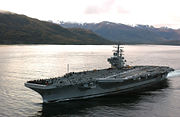
The president holds the title of commander-in-chief of the nation's armed forces and appoints its leaders, the secretary of defense and the Joint Chiefs of Staff. The United States Department of Defense administers the armed forces, including the Army, the Navy, the Marine Corps, and the Air Force. The Coast Guard falls under the jurisdiction of the Department of Homeland Security in peacetime and the Department of the Navy in times of war. In 2005, the military had 1.38 million personnel on active duty, along with several hundred thousand each in the Reserves and the National Guard for a total of 2.3 million troops. The Department of Defense also employs approximately 700,000 civilians, disregarding contractors. Military service is voluntary, though conscription may occur in wartime through the Selective Service System. The rapid deployment of American forces is facilitated by the Air Force's large fleet of transportation aircraft and aerial refueling tankers, the Navy's fleet of eleven active aircraft carriers, and Marine Expeditionary Units at sea in the Navy's Atlantic and Pacific fleets. Outside of the American homeland, the U.S. military is deployed to 770 bases and facilities, on every continent except Antarctica. Because of the extent of its global military presence, scholars describe the United States as maintaining an "empire of bases."
Total U.S. military spending in 2006, over $528 billion, was 46% of the entire military spending in the world and greater than the next fourteen largest national military expenditures combined. (In purchasing power parity terms, it was larger than the next six such expenditures combined.) The per capita spending of $1,756 was approximately ten times the world average. At 4.06% of GDP, U.S. military spending is ranked 27th out of 172 nations. The proposed base Department of Defense budget for 2009, $515.4 billion, is a 7% increase over 2008 and a nearly 74% increase over 2001. The estimated total cost of the Iraq War to the United States through 2016 is $2.267 trillion. As of June 6, 2008, the United States had suffered 4,092 military fatalities during the war and nearly 30,000 wounded.
Economy
| National economic indicators | |
|---|---|
| Unemployment | 5.5%May 2008 |
| GDP growth | 0.9%1Q 2008 (2.2%)2007 |
| CPI inflation | 3.9%April 2007–April 2008 |
| National debt | $9.502 trillionJuly 10, 2008 |
| Poverty | 12.3% or 13.3%2006 |
The United States has a capitalist mixed economy, which is fueled by abundant natural resources, a well-developed infrastructure, and high productivity. According to the International Monetary Fund, the United States GDP of more than $13 trillion constitutes over 25.5% of the gross world product at market exchange rates and over 19% of the gross world product at purchasing power parity (PPP). The largest national GDP in the world, it was slightly less than the combined GDP of the European Union at PPP in 2006. The country ranks eighth in the world in nominal GDP per capita and fourth in GDP per capita at PPP. The United States is the largest importer of goods and third largest exporter, though exports per capita are relatively low. Canada, China, Mexico, Japan, and Germany are its top trading partners. The leading export commodity is electrical machinery, while vehicles constitute the leading import.
The private sector constitutes the bulk of the economy, with government activity accounting for 12.4% of GDP. The economy is postindustrial, with the service sector contributing 67.8% of GDP. The leading business field by gross business receipts is wholesale and retail trade; by net income it is finance and insurance. The United States remains an industrial power, with chemical products the leading manufacturing field. The United States is the third largest producer of oil in the world. It is the world's number one producer of electrical and nuclear energy, as well as liquid natural gas, sulfur, phosphates, and salt. While agriculture accounts for just under 1% of GDP, the United States is the world's top producer of corn and soybeans. The country's leading cash crop is marijuana, despite federal laws making its cultivation and sale illegal. The New York Stock Exchange is the world's largest by dollar volume. Coca-Cola and McDonald's are the two most recognized brands in the world.
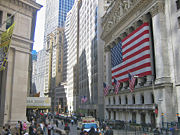
In 2005, 155 million persons were employed with earnings, of whom 80% worked in full-time jobs. The majority, 79%, were employed in the service sector. With approximately 15.5 million people, health care and social assistance is the leading field of employment. About 12% of American workers are unionized, compared to 30% in Western Europe. The U.S. ranks number one in the ease of hiring and firing workers, according to the World Bank. Between 1973 and 2003, a year's work for the average American grew by 199 hours. Partly as a result, the United States maintains the highest labor productivity in the world. However, it no longer leads the world in productivity per hour as it did from the 1950s through the early 1990s; workers in Norway, France, Belgium, and Luxembourg are now more productive per hour. The United States ranks third in the World Bank's Ease of Doing Business Index. Compared to Europe, U.S. property and corporate income taxes are generally higher, while labor and, particularly, consumption taxes are lower.
Income and human development
According to the Census Bureau, the pretax median household income in 2006 was $48,201. The two-year average ranged from $66,752 in New Jersey to $34,343 in Mississippi. Using purchasing power parity exchange rates, these income levels are similar to those found in other postindustrial nations. Depending on the method of analysis, 12.3% or 13.3% of Americans were below the federally designated poverty line. The number of poor Americans, at least 36.5 million, was actually 3.5 million more than in 2001, the bottom year of the most recent U.S. recession. Spending on the social safety net is relatively low: the United States redistributes between 8 and 9% of GDP through social protection programs, slightly under the Japanese rate and less than half the estimated 19% of the European Union. The United States was ranked twelfth in the world in the UNDP's 2008 Human Development Report. A 2007 UNICEF study of children's well-being in twenty-one industrialized nations, covering a broad range of factors, ranked the U.S. next to last.
Between 1967 and 2006, median household income rose 30.8% in constant dollars, largely because of the growing number of dual-earner households. Though the standard of living has improved for nearly all classes since the late 1970s, income inequality has grown substantially. The share of income received by the top 1% has risen considerably while the share of income of the bottom 90% has fallen, with the gap between the two groups being roughly as large in 2005 as in 1928. According to the standard Gini index, income inequality in the United States is higher than in any European nation. Some economists, such as Alan Greenspan, see rising income inequality as a cause for concern. Wealth is highly concentrated: The richest 10% of the adult population possesses 69.8% of the country's household wealth, the second-highest share of any democratic developed nation. The top 1% possesses 33.4% of net wealth.
Science and technology
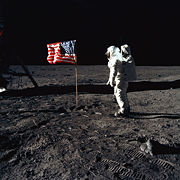
The United States has been a leader in scientific research and technological innovation since the late nineteenth century. In 1876, Alexander Graham Bell was awarded the first U.S. patent for the telephone. The laboratory of Thomas Edison developed the phonograph, the first long-lasting light bulb, and the first viable movie camera. In the early twentieth century, the automobile companies of Ransom E. Olds and Henry Ford pioneered assembly line manufacturing. The Wright brothers, in 1903, made what is recognized as the " first sustained and controlled heavier-than-air powered flight." The rise of Nazism in the 1930s led many important European scientists, including Albert Einstein and Enrico Fermi, to immigrate to the United States. During World War II, the U.S.-based Manhattan Project developed nuclear weapons, ushering in the Atomic Age. The Space Race produced rapid advances in rocketry, materials science, and computers. The United States largely developed the ARPANET and its successor, the Internet. Today, the bulk of research and development funding, 64%, comes from the private sector. The United States leads the world in scientific research papers and impact factor. Americans enjoy high levels of access to technological consumer goods, and almost half of U.S. households have broadband Internet service. The country is the primary developer and grower of genetically modified food; more than half of the world's land planted with biotech crops is in the United States.
Transportation

As of 2003, there were 759 automobiles per 1,000 Americans, compared to 472 per 1,000 inhabitants of the European Union the following year. Approximately 39% of personal vehicles are vans, SUVs, or light trucks. The average American adult (accounting for all drivers and nondrivers) spends 55 minutes behind the wheel every day, driving 29 miles (47 km). The U.S. intercity passenger rail system is relatively weak. Only 9% of total U.S. work trips employ mass transit, compared to 38.8% in Europe. Bicycle usage is minimal, well below European levels. The civil airline industry is entirely privatized, while most major airports are publicly owned. The five largest airlines in the world by passengers carried are all American; American Airlines is number one. Of the world's thirty busiest passenger airports, sixteen are in the United States, including the busiest, Hartsfield-Jackson Atlanta International Airport (ATL).
Energy
The United States energy market is 29,000 terawatt hours per year. Energy consumption per capita is 7.8 tons of oil equivalent per year, compared to Germany's 4.2 tons and Canada's 8.3 tons. In 2005, 40% of the nation's energy came from petroleum, 23% from coal, and 22% from natural gas. The remainder was supplied by nuclear power and various renewable energy sources. The United States is the world's largest consumer of petroleum. For decades, nuclear power has played a limited role relative to many other developed countries. Recently, applications for new nuclear plants have been filed.
Demographics
As of 2008, the United States population was estimated by the U.S. Census Bureau to be 304,516,000. The U.S. population included an estimated 12 million unauthorized migrants, of whom an estimated 1 million were uncounted by the Census Bureau. The overall growth rate is 0.89%, compared to 0.16% in the European Union. The birth rate of 14.16 per 1,000 is 30% below the world average, while higher than any European country except for Albania and Ireland. In 2006, 1.27 million immigrants were granted legal residence. Mexico has been the leading source of new U.S. residents for over two decades; since 1998, China, India, and the Philippines have been in the top four sending countries every year. The United States is the only industrialized nation in which large population increases are projected.
The United States has a very diverse population—thirty-one ancestry groups have more than a million members. Whites are the largest racial group, with German Americans, Irish Americans, and English Americans constituting three of the country's four largest ancestry groups. African Americans constitute the nation's largest racial minority and third largest ancestry group. Asian Americans are the country's second largest racial minority; the two largest Asian American ancestry groups are Chinese and Filipino. In 2006, the U.S. population included an estimated 4.5 million people with some American Indian or Alaskan native ancestry (2.9 million exclusively of such ancestry) and over 1 million with some native Hawaiian or Pacific island ancestry (0.5 million exclusively).
| Race/Ethnicity (2006) | |
|---|---|
| White | 80.1% |
| African American | 12.8% |
| Asian | 4.4% |
| Native American and Alaskan Native | 1.0% |
| Native Hawaiian and Pacific Islander | 0.2% |
| Multiracial | 1.6% |
| Hispanic or Latino (of any race) | 14.8% |
The population growth of Hispanic and Latino Americans has been a major demographic trend. Approximately 44 million Americans are of Hispanic descent, with about 64% possessing Mexican ancestry. Between 2000 and 2006, the country's Hispanic population increased 25.5% while the non-Hispanic population rose just 3.5%. Much of this growth is from immigration; as of 2004, 12% of the U.S. population was foreign-born, over half that number from Latin America. Fertility is also a factor; the average Hispanic woman gives birth to three children in her lifetime. The comparable fertility rate is 2.2 for non-Hispanic black women and 1.8 for non-Hispanic white women (below the replacement rate of 2.1). Hispanics and Latinos accounted for nearly half of the national population growth of 2.9 million between July 2005 and July 2006.
About 83% of the population lives in one of the country's 363 metropolitan areas. In 2006, 254 incorporated places in the United States had populations over 100,000, nine cities had more than 1 million residents, and four global cities had over 2 million (New York City, Los Angeles, Chicago, and Houston). The United States has fifty metropolitan areas with populations greater than 1 million. Of the fifty fastest-growing metro areas, twenty-three are in the West and twenty-five in the South. Among the country's twenty most populous metro areas, those of Dallas (the fourth largest), Houston (sixth), and Atlanta (ninth) saw the largest numerical gains between 2000 and 2006, while that of Phoenix (thirteenth) grew the largest in percentage terms.
| Leading population centers | ||||||||||
|---|---|---|---|---|---|---|---|---|---|---|
| Rank | Core city | State | Pop. | Metro area rank | Metro area pop. | Region |
 New York City  Los Angeles |
|||
| 1 | New York City | New York | 8,250,567 | 1 | 18,818,536 | Northeast | ||||
| 2 | Los Angeles | California | 3,849,378 | 2 | 12,950,129 | West | ||||
| 3 | Chicago | Illinois | 2,833,321 | 3 | 9,505,748 | Midwest | ||||
| 4 | Houston | Texas | 2,169,248 | 6 | 5,539,949 | South | ||||
| 5 | Phoenix | Arizona | 1,512,986 | 13 | 4,039,182 | West | ||||
| 6 | Philadelphia | Pennsylvania | 1,448,394 | 5 | 5,826,742 | Northeast | ||||
| 7 | San Antonio | Texas | 1,296,682 | 29 | 1,942,217 | South | ||||
| 8 | San Diego | California | 1,256,951 | 17 | 2,941,454 | West | ||||
| 9 | Dallas | Texas | 1,232,940 | 4 | 6,003,967 | South | ||||
| 10 | San Jose | California | 929,936 | 30 | 1,787,123 | West | ||||
| 2006 U.S. Census Bureau estimates | ||||||||||
Language
| Languages (2003) | |
|---|---|
| English (only) | 214.8 million |
| Spanish, incl. Creole | 29.7 million |
| Chinese | 2.2 million |
| French, incl. Creole | 1.9 million |
| Tagalog | 1.3 million |
| Vietnamese | 1.1 million |
| German | 1.1 million |
English is the de facto national language. Although there is no official language at the federal level, some laws—such as U.S. naturalization requirements—standardize English. In 2003, about 215 million, or 82% of the population aged five years and older, spoke only English at home. Spanish, spoken by over 10% of the population at home, is the second most common language and the most widely taught foreign language. Some Americans advocate making English the country's official language, as it is in at least twenty-eight states. Both Hawaiian and English are official languages in Hawaii by state law. While neither has an official language, New Mexico has laws providing for the use of both English and Spanish, as Louisiana does for English and French. Other states, such as California, mandate the publication of Spanish versions of certain government documents including court forms. Several insular territories grant official recognition to their native languages, along with English: Samoan and Chamorro are recognized by Samoa and Guam, respectively; Carolinian and Chamorro are recognized by the Northern Mariana Islands; Spanish is an official language of Puerto Rico.
Religion
The United States government does not audit Americans' religious beliefs. In a private survey conducted in 2001, 76.5% of American adults identified themselves as Christian, down from 86.4% in 1990. Protestant denominations accounted for 52% of adult Americans, while Roman Catholics, at 24.5%, were the largest individual denomination. A different study describes white evangelicals, 26.3% of the population, as the country's largest religious cohort; evangelicals of all races are estimated at 30–35%. The total reporting non-Christian religions in 2001 was 3.7%, up from 3.3% in 1990. The leading non-Christian faiths were Judaism (1.4%), Islam (0.5%), Buddhism (0.5%), Hinduism (0.4%), and Unitarian Universalism (0.3%). Between 1990 and 2001, the number of Muslims and Buddhists more than doubled. From 8.2% in 1990, 14.1% in 2001 described themselves as agnostic, atheist, or simply having no religion, still significantly less than in other postindustrial countries such as Britain (2005:44%) and Sweden (2001:69%, 2005:85%).
Education
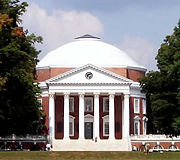
American public education is operated by state and local governments, regulated by the United States Department of Education through restrictions on federal grants. Children are required in most states to attend school from the age of six or seven (generally, kindergarten or first grade) until they turn eighteen (generally bringing them through 12th grade, the end of high school); some states allow students to leave school at sixteen or seventeen. About 12% of children are enrolled in parochial or nonsectarian private schools. Just over 2% of children are homeschooled. The United States has many competitive private and public institutions of higher education, as well as local community colleges of varying quality with open admission policies. Of Americans twenty-five and older, 84.6% graduated from high school, 52.6% attended some college, 27.2% earned a bachelor's degree, and 9.6% earned graduate degrees. The basic literacy rate is approximately 99%. The United Nations assigns the United States an Education Index of 0.97, tying it for twelfth-best in the world.
Health
The American life expectancy of 77.8 years at birth is a year shorter than the overall figure in Western Europe, and three to four years lower than that of Norway, Switzerland, and Canada. Over the past two decades, the country's rank in life expectancy has dropped from 11th to 42nd place in the world. The infant mortality rate of 6.37 per thousand likewise places the United States 42nd out of 221 countries, behind all of Western Europe. U.S. cancer survival rates are the highest in the world. Approximately one-third of the adult population is obese and an additional third is overweight; the obesity rate, the highest in the industrialized world, has more than doubled in the last quarter-century. Obesity-related type 2 diabetes is considered epidemic by healthcare professionals. The U.S. adolescent pregnancy rate, 79.8 per 1,000 women, is nearly four times that of France and five times that of Germany. Abortion in the United States, legal on demand, is a source of great political controversy. Many states ban public funding of the procedure and have laws to restrict late-term abortions, require parental notification for minors, and mandate a waiting period prior to treatment. While the incidence of abortion is in decline, the U.S. abortion ratio of 241 per 1,000 live births and abortion rate of 15 per 1,000 women aged 15–44 remain higher than those of most Western nations.
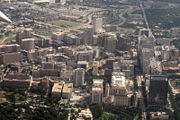
The United States healthcare system far outspends any other nation's, measured in both per capita spending and percentage of GDP. Unlike most developed countries, the U.S. healthcare system is not universal, and relies on a higher proportion of private funding. In 2004, private insurance paid for 36% of personal health expenditure, private out-of-pocket payments covered 15%, and federal, state, and local governments paid for 44%. The World Health Organization ranked the U.S. healthcare system in 2000 as first in responsiveness, but 37th in overall performance. The United States is a leader in medical innovation. In 2004, the U.S. nonindustrial sector spent three times as much as Europe per capita on biomedical research. Medical bills are the most common reason for personal bankruptcy in the United States. In 2005, 46.6 million Americans, or 15.9% of the population, were uninsured, 5.4 million more than in 2001. The primary cause of the decline in coverage is the drop in the number of Americans with employer-sponsored health insurance, which fell from 62.6% in 2001 to 59.5% in 2005. Approximately one third of the uninsured lived in households with annual incomes greater than $50,000, with half of those having an income over $75,000. Another third were eligible but not registered for public health insurance. In 2006, Massachusetts became the first state to mandate health insurance; California is considering similar legislation.
Crime and punishment
Law enforcement in the United States is primarily the responsibility of local police and sheriff's departments, with state police providing broader services. Federal agencies such as the Federal Bureau of Investigation (FBI) and the U.S. Marshals Service have specialized duties. At the federal level and in almost every state, jurisprudence operates on a common law system. State courts conduct most criminal trials; federal courts handle certain designated crimes as well as appeals from state systems.
Among developed nations, the United States has above-average levels of violent crime and particularly high levels of gun violence and homicide. In 2006, there were 5.7 murders per 100,000 persons, three times the rate in neighboring Canada. The U.S. homicide rate, which decreased by 42% between 1991 and 1999, has been roughly steady since. Some scholars have associated the high rate of homicide with the country's high rates of gun ownership, in turn associated with U.S. gun laws which are very permissive compared to those of other developed countries.
The United States has the highest documented incarceration rate and total prison population in the world and by far the highest figures among democratic, developed nations. At the start of 2008, more than 2.3 million people were held in American prisons or jails, more than one in every 100 adults. The current rate is almost seven times the 1980 figure. African American males are jailed at over six times the rate of white males and three times the rate of Hispanic males. In the latest comparable data, from 2006, the U.S. incarceration rate was more than three times the figure in Poland, the Organisation for Economic Co-operation and Development (OECD) country with the next highest rate. The country's extraordinary rate of incarceration is largely caused by changes in sentencing and drug policies. Though it has been abolished in most Western nations, capital punishment is sanctioned in the United States for certain federal and military crimes, and in thirty-seven states. Since 1976, when the U.S. Supreme Court reinstated the death penalty after a four-year moratorium, there have been over 1,000 executions in the United States. In 2006, the country had the sixth highest number of executions in the world, following China, Iran, Pakistan, Iraq, and Sudan. In December 2007, New Jersey became the first state to abolish the death penalty since the 1976 Supreme Court decision.
Culture
The United States is a multicultural nation, home to a wide variety of ethnic groups, traditions, and values. There is no "American" ethnicity; aside from the now relatively small Native American population, nearly all Americans or their ancestors immigrated within the past five centuries. The culture held in common by the majority of Americans is referred to as mainstream American culture, a Western culture largely derived from the traditions of Western European migrants, beginning with the early English and Dutch settlers. German, Irish, and Scottish cultures have also been very influential. Certain cultural attributes of Mandé and Wolof slaves from West Africa were adopted by the American mainstream; based more on the traditions of Central African Bantu slaves, a distinct African American culture developed that would eventually have a major effect on the mainstream as well. Westward expansion integrated the Creoles and Cajuns of Louisiana and the Hispanos of the Southwest and brought close contact with the culture of Mexico. Large-scale immigration in the late nineteenth and early twentieth centuries from Southern and Eastern Europe introduced many new cultural elements. More recent immigration from Asia and especially Latin America has had broad impact. The resulting mix of cultures may be characterized as a homogeneous melting pot or as a pluralistic salad bowl in which immigrants and their descendants retain distinctive cultural characteristics.
While American culture maintains that the United States is a classless society, economists and sociologists have identified cultural differences between the country's social classes, affecting socialization, language, and values. The American middle and professional class has been the source of many contemporary social trends such as feminism, environmentalism, and multiculturalism. Americans' self-images, social viewpoints, and cultural expectations are associated with their occupations to an unusually close degree. While Americans tend greatly to value socioeconomic achievement, being ordinary or average is generally seen as a positive attribute. Though the American Dream, or the perception that Americans enjoy high social mobility, played a key role in attracting immigrants, particularly in the late 1800s, some analysts find that the United States has less social mobility than Western Europe and Canada.
Women, many of whom were formerly more limited to domestic roles, now mostly work outside the home and receive a majority of bachelor's degrees. The changing role of women has also changed the American family. In 2005, no household arrangement defined more than 30% of households; married childless couples were most common, at 28%. The extension of marital rights to homosexual persons is an issue of debate; several more liberal states permit civil unions in lieu of marriage. In 2003, the Massachusetts Supreme Judicial Court ruled that state's ban on same-sex marriage unconstitutional; the Supreme Court of California ruled similarly in 2008. Forty-three states still legally restrict marriage to the traditional man-and-woman model.
Literature, philosophy, and the arts
In the eighteenth and early nineteenth centuries, American art and literature took most of its cues from Europe. Writers such as Nathaniel Hawthorne, Edgar Allan Poe, and Henry David Thoreau established a distinctive American literary voice by the middle of the nineteenth century. Mark Twain and poet Walt Whitman were major figures in the century's second half; Emily Dickinson, virtually unknown during her lifetime, is recognized as another essential American poet. Eleven U.S. citizens have won the Nobel Prize in Literature, most recently Toni Morrison in 1993. Ernest Hemingway, the 1954 Nobel laureate, is often named as one of the most influential writers of the twentieth century. A work seen as capturing fundamental aspects of the national experience and character—such as Herman Melville's Moby-Dick (1851), Twain's The Adventures of Huckleberry Finn (1885), and F. Scott Fitzgerald's The Great Gatsby (1925)—may be dubbed the " Great American Novel." Popular literary genres such as the Western and hardboiled crime fiction developed in the United States. Postmodernism is the most recent major literary movement in the world, and though on the theory side postmodernism began with French writers like Jacques Derrida and Alain Robbe-Grillet, and was transitioned into largely by Irish writer Samuel Beckett, it has since been dominated by American writers such as Thomas Pynchon, Don DeLillo, William S. Burroughs, Jack Kerouac, John Barth, E.L. Doctorow, Kurt Vonnegut and many others.
The transcendentalists, led by Ralph Waldo Emerson and Thoreau, established the first major American philosophical movement. After the Civil War, Charles Peirce and then William James and John Dewey were leaders in the development of pragmatism. In the twentieth century, the work of W. V. Quine and Richard Rorty helped bring analytic philosophy to the fore in U.S. academic circles.
In the visual arts, the Hudson River School was an important mid-nineteenth-century movement in the tradition of European naturalism. The 1913 Armory Show in New York City, an exhibition of European modernist art, shocked the public and transformed the U.S. art scene. Georgia O'Keeffe, Marsden Hartley, and others experimented with new styles, displaying a highly individualistic sensibility. Major artistic movements such as the abstract expressionism of Jackson Pollock and Willem de Kooning and the pop art of Andy Warhol and Roy Lichtenstein have developed largely in the United States. The tide of modernism and then postmodernism has also brought American architects such as Frank Lloyd Wright, Philip Johnson, and Frank Gehry to the top of their field.
One of the first notable promoters of the nascent American theatre was impresario P. T. Barnum, who began operating a lower Manhattan entertainment complex in 1841. The team of Harrigan and Hart produced a series of popular musical comedies in New York starting in the late 1870s. In the twentieth century, the modern musical form emerged on Broadway; the songs of musical theatre composers such as Irving Berlin, Cole Porter, and Stephen Sondheim have become pop standards. Playwright Eugene O'Neill won the Nobel literature prize in 1936; other acclaimed U.S. dramatists include multiple Pulitzer Prize winners Tennessee Williams, Edward Albee, and August Wilson.
Though largely overlooked at the time, Charles Ives's work of the 1910s established him as the first major U.S. composer in the classical tradition; other experimentalists such as Henry Cowell and John Cage created an identifiably American approach to classical composition. Aaron Copland and George Gershwin developed a unique American synthesis of popular and classical music. Choreographers Isadora Duncan and Martha Graham were central figures in the creation of modern dance; George Balanchine and Jerome Robbins were leaders in twentieth-century ballet. The United States has long been at the fore in the relatively modern artistic medium of photography, with major practitioners such as Alfred Stieglitz, Edward Steichen, Ansel Adams, and many others. The newspaper comic strip and the comic book are both U.S. innovations. Superman, the quintessential comic book superhero, has become an American icon.
Food

Mainstream American culinary arts are similar to those in other Western countries. Wheat is the primary cereal grain. Traditional American cuisine uses ingredients such as turkey, white-tailed deer venison, potatoes, sweet potatoes, corn, squash, and maple syrup, indigenous foods employed by Native Americans and early European settlers. Slow-cooked pork and beef barbecue, crab cakes, potato chips, and chocolate chip cookies are distinctively American styles. Soul food, developed by African slaves, is popular around the South and among many African Americans elsewhere. Syncretic cuisines such as Louisiana creole, Cajun, and Tex-Mex are regionally important. Characteristic dishes such as apple pie, fried chicken, pizza, hamburgers, and hot dogs derive from the recipes of various immigrants. French fries, Mexican dishes such as burritos and tacos, and pasta dishes freely adapted from Italian sources are widely consumed. Americans generally prefer coffee to tea. Marketing by U.S. industries is largely responsible for making orange juice and milk ubiquitous breakfast beverages. During the 1980s and 1990s, Americans' caloric intake rose 24%; frequent dining at fast food outlets is associated with what health officials call the American "obesity epidemic." Highly sweetened soft drinks are widely popular; sugared beverages account for 9% of the average American's caloric intake.
Sports
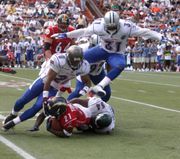
Since the late nineteenth century, baseball has been regarded as the national sport; football, basketball, and ice hockey are the country's three other leading professional team sports. College football and basketball also attract large audiences. Football is now by several measures the most popular spectator sport in the United States. Boxing and horse racing were once the most watched individual sports, but they have been eclipsed by golf and auto racing, particularly NASCAR. Soccer, though not a leading professional sport in the country, is played widely at the youth and amateur levels. Tennis and many outdoor sports are also popular.
While most major U.S. sports have evolved out of European practices, basketball, volleyball, skateboarding, and snowboarding are American inventions. Lacrosse and surfing arose from Native American and Native Hawaiian activities that predate Western contact. Eight Olympic Games have taken place in the United States. The United States has won 2,191 medals at the Summer Olympic Games, more than any other country, and 216 in the Winter Olympic Games, the second most.


